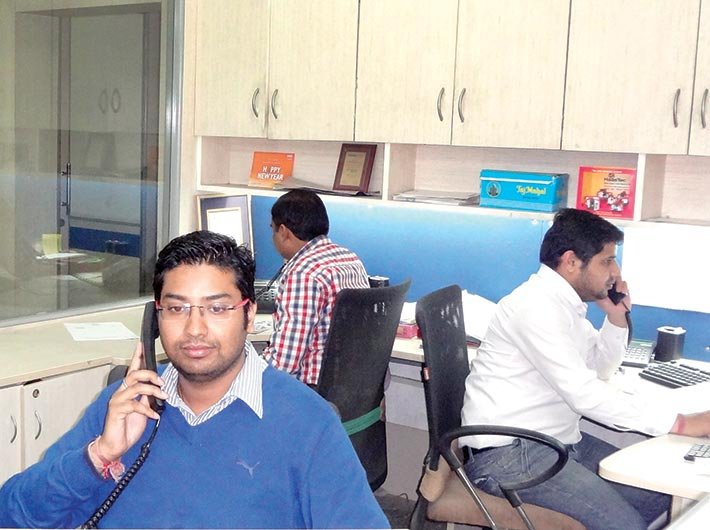Bashir Thakur, who settled in Qatar 24 years ago, didn’t vote in the Delhi assembly elections but, in many ways, was a harbinger of change that swept the capital in February. Thakur, a mechanical engineer, originally belongs to Maharashtra, but the distance between Delhi and his hometown or his place of residence could not stop him from contributing to the campaign of the Aam Aadmi Party (AAP). Deeply influenced by the AAP chief and now Delhi chief minister, Arvind Kejriwal, and his anti-corruption crusade, Thakur wanted to contribute to the cause. So, he volunteered to call and convince Delhi voters to vote for AAP. And he did this living in Qatar.
In the run-up to the election, Thakur would wrap up his office work at 1 pm (Qatar time, IST 3:15 pm) before picking up his mobile phone and, like a dedicated AAP volunteer, start persuading people to vote for AAP. The conversation, mostly in Hindi, would start with, “Namaste, mera naam Basheer Thakur hai… kya aap ko malum hai ki Delhi ke election 7 February ko hone wale hain? Kya aap ka voter card ban gaya hai?” (Greetings, my name is Basheer Thakur… Do you know the Delhi election is being held on February 7? Have you got your voter ID card?)
Thakur was working well past his office hours (6 am to 1 pm) every day for more than a month. As the election approached, he took a week off from office and became a full-time AAP
volunteer – making over 100 calls a day. From mid-December to February 5, Thakur says he spoke to 4,400 Delhi voters, pitching for Kejriwal and his party.
Thakur belongs to a group of 30,000 committed volunteers spread across 40 countries and 25 Indian states who made their contribution to AAP’s sweeping victory in Delhi. In a span of a month-and-a-half, these volunteers spoke to over 10 lakh Delhi voters and answered their queries and apprehensions related to the party. A typical conversation lasted for two minutes, with a few extending to seven minutes, especially when the voter on call was a BJP or Narendra Modi supporter.
It is interesting to note that the maximum number of calls were made from Maharashtra (2,11,641), followed by Delhi (1,30,472), Uttar Pradesh (91,846), Karnataka (90,191) and Madhya Pradesh (60,675). The maximum number of calls made by non-resident Indians were from the United States (18,258), followed by Canada (15,687), Qatar (5,194), Japan (4,276) and Australia (2,818).
On an average, AAP volunteers were speaking to 250 voters every second. In the two weeks immediately preceding the election, 60,000 calls were made every day. Since the whole campaign was technology driven – via a toll-free number and internet – all call-related data was available in real-time, Kartikeya Maheshwary, an AAP loyalist based in the US told Governance Now in an email interaction. A software engineer, Maheshwary works for a financial trading firm in Philadelphia. He had set up a virtual war room and provided status and feedback to AAP leaders on the campaign round the clock.
Campaign
“As part of the campaign, we told the voters that they need not move out of their homes to contribute for AAP,” said Rashmi, an AAP member. Party volunteers could approach voters in two ways after registering themselves online. One option was that volunteers could visit the website, get the contact details of the voter and call them directly. The other option was that they could call on a toll-free number (1800-200-9424/ +911203803405) and a software would then route them to voters.
After every conversation, callers had to submit their feedback. Those using the toll-free number had to press ‘1’ for a positive response, ‘2’ for a negative response and ‘3’ if the voter seemed to be neutral. The party had a database of 20-30 lakh voters.
Calling and pulling volunteers for party work was first mooted by the Dallas chapter of the party in mid-2013, which later kick-started the citizen calling campaign. Rashmi of AAP was in Dallas then. “We used to call from there and request people to visit the party office in Delhi. Later, Arvind [Kejriwal] suggested us to start focusing on the voters. We made a portal for call campaign,” Rashmi said.
Knowlarity, a Gurgaon-based start-up in cloud telephony, provided the toll-free number, software and storage facility for managing the calling campaign. “Knowlarity’s infrastructure supported 270 calls per second during peak time,” said its CEO Ambrish Gupta. A dedicated support team was set up for real-time monitoring.
The data was stored locally, as well as on Amazon cloud. It was also being shared with AAP on real-time basis, said Gupta. In addition to this, the company also provided real-time access to telephonic conversations between callers and voters so as to keep a track of callers’ performance and to keep a check on possible misuse by BJP or Congress supporters.
Earlier, in the Delhi assembly (2013) and Lok Sabha (2014) elections, AAP had a similar setup, but it was not monitored. As a result, the toll-free number was used by supporters of a rival party for their own benefit as they tried to persuade voters to vote for their party. This time, if a caller was found having allegiance to other parties, he or she was promptly blocked.
Though all calls were recorded, not all of them were listened to by the AAP monitoring cell. “We provided them a configurable setting where every ‘n’th call would go to a particular monitoring cell member,” said Gupta.
Impact
The campaign provided inputs about what voters were thinking, Bhaskar Singh, an AAP member who drove the calling campaign, said. “Volunteers countered and demystified whatever rumour was spread in public [by opposition parties],” Singh added.
“Volunteers used WhatsApp to inform us about the issues people were raising. Based on their feedback, we devised our strategy, in coordination with our media team,” Singh said. “We had 20 different WhatsApp groups, each comprising 100 callers who made over 100 calls on a daily basis.”
AAP had also alerted volunteers to be cautious of two things. First, if people called Kejriwal bhagoda (a deserter, for resigning soon after becoming the chief minister), they had to tell voters that he had apologised and had assured that he would not repeat the mistake this time. Second, if the voter was a Modi supporter, volunteers were strictly told not to get into an argument.
Based on the feedback from callers, the party sent text and voice messages to all volunteers on a daily basis, apprising them of party positions (on various issues) and promises.
When the BJP announced Kiran Bedi as the CM candidate, there were apprehensions within the AAP as to how it was going to impact their wining prospects. “We wanted to know what callers were hearing from voters. We then asked whether they heard something about Bedi. Callers told us that there were only a few instances when voters talked about Bedi. In four or five days we were clear that it was not going to make much of a difference,” said Singh.
The campaign also helped AAP focus on the constituencies where AAP had less chances of winning. A week before the voting day, the party focused on 35 weaker constituencies and started making calls. These were majorly those constituencies where the party had lost in 2013 and a few which they might have lost this time, including Shakurbasti, Timarpur, Seelampur and Mustafabad.
“We had only seven days, between January 30 and February 5. We took 10,000 voters’ numbers from all these constituencies and started calling them. Within a few days, pie charts started turning green (positive response for AAP) in these constituencies,” Rashmi said.
When the campaign team showed pie charts to Satendar Jain, party MLA from Shakurbasti, he didn’t believe it. “How can all this be green, there might be something wrong?” he told the team.
On December 24 when the calling started, only 50 percent of voters were in favour of voting for AAP. By February 1, the number rose to close to 80 percent (a graph provided by AAP shows this trend).
The party spent around '35 lakh on the campaign. There were 12 people from the party who were supporting, mentoring and monitoring these callers. “Within this team, we had delineated responsibilities. We formed groups: leadership coordination, regional coordination, help-line, promotion and recognition. This helped the campaign team to manage its affairs in a better manner,” Rashmi said.
Technology has indeed helped Kejriwal into the driver’s seat in Delhi, he now has to leverage it to steer governance. Any laxity, and the charts and graphs will have turned red. Some accidents are near fatal, Kejriwal knows from experience.
[email protected]
(The article appeared in March 1-15, 2015, issue)



